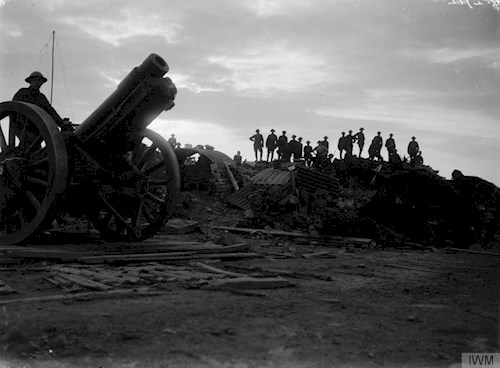 The Third Battle of Ypres became infamous, not only for the scale of casualties, but also for the mud.
The Third Battle of Ypres became infamous, not only for the scale of casualties, but also for the mud.
Ypres was the principal town within a salient (or bulge) in the British lines and the site of two previous battles: First Ypres (October-November 1914) and Second Ypres (April-May 1915). Haig had long wanted a British offensive in Flanders and following intelligence that the German blockade would soon cripple the British war effort, wanted to reach the Belgian coast to destroy German submarine bases there. Also the possibility of a Russian withdrawal from the war threatened German redeployment from the Eastern front to increase their reserve strength dramatically.
The British were further encouraged by the success of the attack on Messines Ridge on 7 June 1917. Nineteen huge mines were exploded simultaneously after they had been placed at the end of long tunnels under the German front lines. The capture of the ridge gave Haig encouragement and preparations began. However the flatness of the plain made stealth impossible and, as with the Somme, the Germans knew an attack was imminent and the initial bombardment served as a final warning. It lasted two weeks with 4.5 million shells fired from 3,000 guns but again failed to destroy the heavily fortified German positions.
The infantry attack began on 31 July. Constant shelling had churned the clay and smashed the drainage systems. The left wing of the attack achieved its objectives but the right wing failed completely. Within a few days, the heaviest rain for 30 years had turned the ground into a quagmire of thick mud which clogged up rifles and bogged down tanks and artillery. It became so deep eventually that men and horses drowned in it.
On 16 August the attack was resumed, stalemate prevailed for another month until an improvement in the weather prompted another attack on 20 September. The Battle of Menin Road Ridge, along with the Battle of Polygon Wood on 26 September and the Battle of Broodseinde on 4 October established British possession of the ridge east of Ypres.
Further attacks in October failed to make much progress. The eventual capture of what little remained of Passchendaele village by British and Canadian forces on 6 November enabled Haig to call off the offensive on 10 November and claim success.
Passchendaele village lay barely five miles beyond the starting point of this offensive which had lasted over three months and resulted in 325,000 Allied and 260,000 German casualties.
From the Passchendaele ridge the Allies then had a clear view of the fields of Flanders which the Germans had invaded in 1914.
